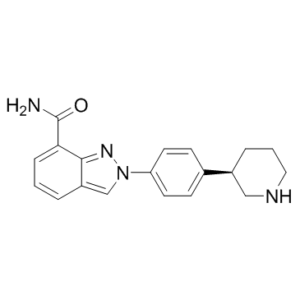Niraparib R-enantiomer
This product is for research use only, not for human use. We do not sell to patients.

For small sizes, please check our retail website as below: www.invivochem.com
| Size | Price | Stock |
|---|---|---|
| 250mg | $450 | Check With Us |
| 500mg | $800 | Check With Us |
| 1g | $1200 | Check With Us |
Cat #: V3790 CAS #: 1038915-58-0 Purity ≥ 98%
Description: Niraparib R-enantiomer, the R-isomer of Niraparib, is a potent PARP1 [poly(ADP-Ribose) polymerase] inhibitor (IC50 = 2.4 nM) with anticancer activity.
Top Publications Citing Invivochem Products
Publications Citing InvivoChem Products
Product Promise

- Physicochemical and Storage Information
- Protocol
- Related Biological Data
- Stock Solution Preparation
- Quality Control Documentation
| Molecular Weight (MW) | 320.39 |
|---|---|
| Molecular Formula | C₁₉H₂₀N₄O |
| CAS No. | 1038915-58-0 |
| Storage | -20℃ for 3 years in powder formr |
| -80℃ for 2 years in solvent | |
| Solubility In Vitro | DMSO: ~500mg/mLr |
| Water: <1mg/mLr | |
| Ethanol: <1mg/mL | |
| Synonyms | Niraparib R-enantiomer; MK 4827 R-enantiomer; MK4827 R-enantiomer |
| Protocol | In Vitro | Niraparib R-enantiomer (MK-4827 R-enantiomer) resolution of Niraparib R-enantiomer give compounds Niraparib R-enantiomer and Niraparib S-enantiomer, both showing excellent inhibition of PARP-1. Niraparib R-enantiomer has somewhat lower in vitro metabolic clearance than the Niraparib S-enantiomer in rat liver microsomes, but Niraparib S-enantiomer is more potent in cell based assays (PARylation EC50, Niraparib R-enantiomer=30 nM, Niraparib S-enantiomer=4.0 nM; BRCA1-HeLa CC50, Niraparib R-enantiomer=470, Niraparib S-enantiomer=34 nM). Given this improved potency and similar in vitro turnover in human liver microsomes (HLM Clint, Niraparib R-enantiomer=4, Niraparib S-enantiomer=3 μL/min/mgP), Niraparib S-enantiomer (Niraparib) is focused on |
|---|
These protocols are for reference only. InvivoChem does not
independently validate these methods.
| Solvent volume to be added | Mass (the weight of a compound) | |||
|---|---|---|---|---|
| Mother liquor concentration | 1mg | 5mg | 10mg | 20mg |
| 1mM | 3.1212 mL | 15.6060 mL | 31.2120 mL | 62.4239 mL |
| 5mM | 0.6242 mL | 3.1212 mL | 6.2424 mL | 12.4848 mL |
| 10mM | 0.3121 mL | 1.5606 mL | 3.1212 mL | 6.2424 mL |
| 20mM | 0.1561 mL | 0.7803 mL | 1.5606 mL | 3.1212 mL |
The molarity calculator equation
Mass(g) = Concentration(mol/L) × Volume(L) × Molecular Weight(g/mol)
Mass
=
Concentration
×
Volume
×
Molecular Weight*
The dilution calculator equation
Concentration(start)
×
Volume(start)
=
Concentration(final)
×
Volume(final)
This equation is commonly abbreviated as: C1 V1 = C2 V2
Concentration(start)
C1
×
Volume(start)
V1
=
Concentration(final)
C2
×
Volume(final)
V2
Step One: Enter information below
Dosage mg/kg
Average weight of animals g
Dosing volume per animal µL
Number of animals
Step Two: Enter the in vivo formulation
%DMSO
+
%
+
%Tween 80
+
%ddH2O
Calculation Results:
Working concentration:
mg/ml;
Method for preparing DMSO master liquid:
mg
drug pre-dissolved in
µL
DMSO(Master liquid concentration
mg/mL)
,Please contact us first if the concentration exceeds the DMSO solubility of the batch of drug.
Method for preparing in vivo formulation:
Take
µL
DMSO master liquid, next add
µL
PEG300, mix and clarify, next add
µL
Tween 80,mix and clarify, next add
µL
ddH2O,mix and clarify.
Note:
- (1) Please be sure that the solution is clear before the addition of next solvent. Dissolution methods like vortex, ultrasound or warming and heat may be used to aid dissolving.
- (2) Be sure to add the solvent(s) in order.




































